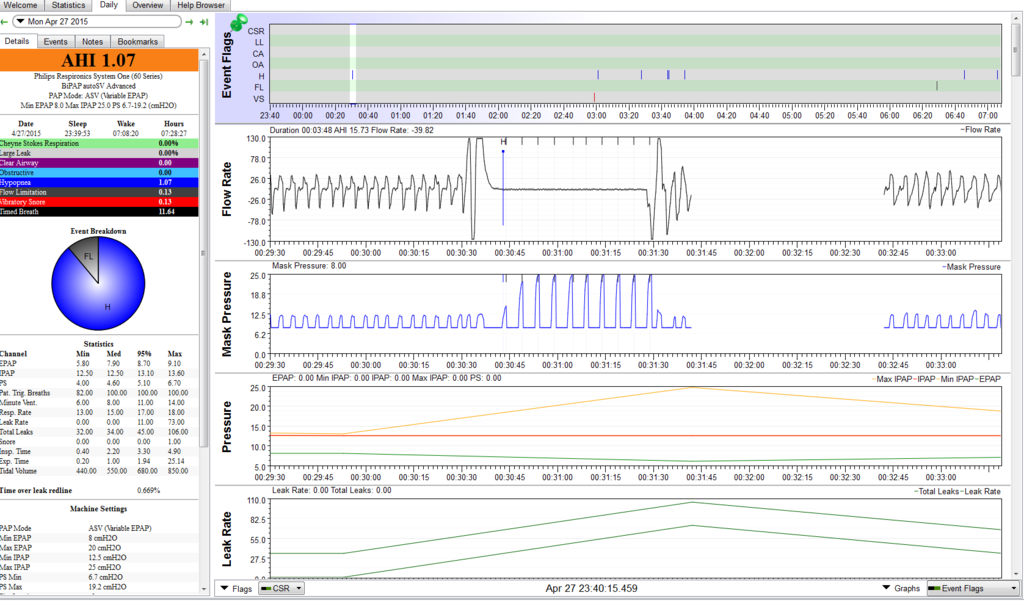Post
by robysue » Tue Apr 28, 2015 7:55 am
There are several things that I notice about this event:
1) Before the minute long apnea/hypopnea happens there are two exceptionally large inhalations. And after the second extremely large inhalation there is no attempt to exhale. If I had to speculate, I'd be wondering whether you had an arousal/mini awakening followed by a minute of breath holding. Moreover---when the event ends, it ends with an exhalation, which is a bit unusual. It's possible that those two big inhalations at the start blew off too much CO2 and without the CO2-trigger, the brain "forgot" to send the diaphragm the "inhale now" signals during that minute. Certainly the ASV responded as if it believes that's what happened. You can see the IPAP drastically increase in the "Mask Pressure" graph on 9 inhalation cycles that don't correspond to any inhalation activity in the flow rate graph.
2) You have a really large exhalation to end the event, followed by two breaths that are larger than your normal sleep breathing, but not as large as the two inhalations just before the event begins. At that point the Flow Rate and Mask Pressure graphs have a gap, but the Total Leak/Leak graphs and the Pressure graph have gaps in them.
Question: What does the Session data in the left side bar say about the beginning and ends of each of the Sessions for the night? In other words, was the machine ON or OFF between 00:31:45 and 00:32:45?
3) When the Flow Rate and Mask Pressure graphs resume at around 00:32:45, the breathing pattern looks to be pretty normal sleep breathing and the Mask Pressure graph shows that the IPAP pressure has gone back to your IPAP min = 12.5.
4) The leak rate started to increase about 00:30:00, which is about 45 seconds before the event starts. The leak rate continues to increase through out the entire event when the machine is drastically increasing the IPAP in an effort to trigger you to inhale. Part of that increase in total leak rate has to be caused by the fact that the IPAP bumps on the Mask Pressure mask go from 12.5cm to 25cm in about 15 seconds just as the machine starts responding to the event. You can see this in the mask pressure graph if you look at the three Mask Pressure bumps that are right around 00:30:45.
5) The maximum point on the Total Leak graph is reached just after the end of the event. At and near the max of the Total Leak graph, the Total Leaks are up around 110 L/min. That's certainly pushing official Large Leak territory, even though the machine did NOT flag it as an official Large Leak. At that point, the machine starts to lower the Max IPAP pressure level, possibly in an attempt to "fix" the much larger than normal leak, but possibly also because those breaths at the end of the event also convinced the machine you were breathing on your own again.
6) The normal sleep breathing pattern resumes when the Total Leak Rate graph has gone down to 82.5 L/min. It's still a pretty large leak, but it's a lot smaller than that peak Total Leak Rate of 110 L/min.
I'm hesitant to speculate about the reason all this happened in the first place. But if I had to guess what went on here, this is what I'd come up with:
At 00:30:30 some kind a small-to-medium sized leak started. You had some kind of an arousal/awakening at 00:30:30 that caused the very, very large inhalations and after that second inhalation you started holding your breath for some reason. The machine starts to respond by increasing the IPAP pretty drastically between 00:30:40 and 00:30:50, but that increase in IPAP causes the leak to grow from medium sized to very large, but not quite large enough to be flagged as an Official Large Leak. At 00:31:30 you exhale pretty forcefully to end the event and have a couple of larger than normal inhalations. By this point the leaks have grown large enough that it's possible the machine simply lost track of your breathing. Or you removed the mask. And because of the large leak, the machine starts lowering the "max IPAP level", probably in hopes of fixing the very large leak. But at any rate, by 00:32:45 the machine can track the breathing, which is already looking very similar to sleep breathing. And by 00:33:00 it's clear that the breathing pattern looks like sleep breathing.
As for what caused you to inhale so sharply and deeply for two breaths around 00:30:30 to start the event? I have no idea. The whole pattern of a few big inhalations, followed by a (short) period of not breathing, followed by a big exhalation and a couple more larger than normal inhalations sometimes occurs when people wake up just enough to turn over in bed. But usually those "turn over in bed" events are more in the 10-15 second range, which is much shorter than this one.



